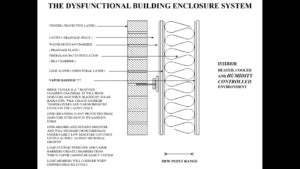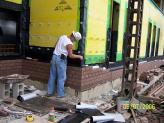Learn how to design effective exterior walls using a vapor barrier system.This program is designed for you to understand the basics of building physics, the basics of building science, the Four Barriers Needed For The Weather Barrier System, and how to properly design and specify the Weather Barrier System. This is Part 4: The Vapor Barrier System. The last of our four-part series.
What are the Four Barriers of the Four Wetting Potentials?
They are Air, Water, Heat and Vapor barriers.
While Part 1 Air Barrier systems. Part 2: Water Barrier systems. Part 3: Heat Barrier System and Part 4: Vapor Barrier System.
There are four wetting potentials affecting exterior walls; Moisture Transport Due To Air Flow (Air Barrier), Liquid Water Ingress (Water Barrier), Dew Point ( Heat Barrier Location), and Vapor Migration ( Vapor Barrier).
How Do We Properly Deal With These Four Wetting Potentials?
These barriers are [H] Heat Barrier, [A] Air Barrier, [M]L Water Barrier ( Liquid Moisture ), [M]V Vapor Barrier ( Gaseous Moisture ). We created the acronym HAMM as a way to remember these four wetting potentials. HAMM is the 4 barriers needed to protect a building against the effects of weather. Together, HAMM is the Weather Barrier System.
Good HAMM effectively deals with thermal transfer, wetting and drying potentials:
Heat Barrier: Thermal loss, thermal gain, and bridging. Wetting potential due to a dew point (location)
Air Barrier: Thermal loss and gain. Wetting potential due to moisture transport via air flow.
Water Barrier: Wetting potential due to liquid moisture intrusion into and through the Building Enclosure System.
Vapor Barrier: Wetting potential due to vapor diffusion into and through the Building Enclosure System.
What is a Vapor Barrier System?
Vapor barriers are materials used in Building Enclosure Systems to retard the diffusion of vapor into and through the building enclosure system.
Why Are Vapor Barriers Needed?
By retarding the diffusion of vapor through the Building Enclosure System, conditions that create dew points within Building Enclosure Systems can be reduced or prevented and interior RH levels can be maintained.
What Is Vapor Diffusion?
Vapor diffusion is the process by which vapor seeks to equalize its content between different environments (the Ideal Gas Law). The driving force for this occurrence is vapor pressure. Vapor pressure is a function of the vapor content of the air ( RH ) and the temperature. Vapor diffusion is caused by a vapor pressure differential ( ∆P ) between different environments. The greater the ∆P between environments, the greater the amount of vapor diffusion that occurs.

The Dew Point
The dew point is the temperature at which air that contains a certain amount of vapor can no longer hold that vapor and must exhaust itself of excess vapor by depositing it on adjacent surfaces in the form of condensation (water). Table 1 (left) Vapor Pressure for various temperatures and relative humidities (pounds per square inch).
Where does the water on the outside of the glass come from?
The dew point is the temperature at which condensation forms on condensing surfaces. When air comes into contact with a surface that is at or below the dew point temperature of that air, condensation will form on it.
 The Dew (condensation) Point Calculator
The Dew (condensation) Point Calculator
Table 2 (left)
EXAMPLE 1: If the interior air temperature is 70˚ F and has an RH of 30%, the infiltration of air that is 37˚ F ( the dew point temperature ) can cool condensing surfaces to this temperature ( 37 ˚ ) causing condensation to form on these surfaces.
EXAMPLE 2: If exterior air with a temperature of 85˚ F and an RH of 70% infiltrates into the building envelope, condensation will form on condensing surfaces in the system that have temperatures of 74˚ F or less.
The Dysfunctional Building Enclosure System
 How much moisture gets in via vapor migration?
How much moisture gets in via vapor migration?
The amount of moisture entering a building through the BES due to vapor migration depends on the vapor pressure differential ( ∆P ) and the perm rating of the material(s) it must pass through. This value is known as the Water Vapor Transmission Rate ( WVTR ). “The calculation is simple,” says Len.
WVTR = A x T x ∆ P x perms
A = Area in sq.ft
T = Time in hours
∆ P = difference in vapor pressure between inside and outside measured in inches of mercury (in Hg)
1 Perm = 1 grain of water / 1 sf of material / hr at a ∆P of 1 in. Hg
1 psi = 2.0434 in HG ( 68˚ F )
EXO-TEC Vapor Barrier Solutions
The air and vapor barriers products from Polyguard will act as the vapor barrier. Here are some specific product names and product page links. Contact Len if you have any questions or not sure which best fits your construction project.
Exo-tec has several waterproofing products from below-grade to rooftop, wall drainage solutions for above- and below-grade waterproofing solutions intended for both pre-concrete and post-concrete pour applications. Our fluid-applied waterproofing and dampproofing products can stand up to the toughest weather and job site conditions. We have air barrier solutions, high tolerance floor solutions, masonry anchors, and soy-based cleaners and strippers.

 Len Anastasi has been working in the construction industry for over 30 years in masonry, waterproofing and restoration work.
He currently owns EXO-TEC Manufacturing, Inc., EXO-TEC Solutions, Inc. and EXO-TEC Consulting, Inc.
In his construction and consulting work, he has performed inspections and repairs on over 300 buildings.
Len has given expert testimony in trials and reviews on dozens of legal cases.
He is a member of ASTM’s E 06 Committee, the Boston Society of Architects Building Enclosure Council, Air Barrier Association of America, the Construction Specifications Institute, and the International Concrete Repair Institute.
Book Len for your Next Event!
Len Anastasi has been working in the construction industry for over 30 years in masonry, waterproofing and restoration work.
He currently owns EXO-TEC Manufacturing, Inc., EXO-TEC Solutions, Inc. and EXO-TEC Consulting, Inc.
In his construction and consulting work, he has performed inspections and repairs on over 300 buildings.
Len has given expert testimony in trials and reviews on dozens of legal cases.
He is a member of ASTM’s E 06 Committee, the Boston Society of Architects Building Enclosure Council, Air Barrier Association of America, the Construction Specifications Institute, and the International Concrete Repair Institute.
Book Len for your Next Event! 